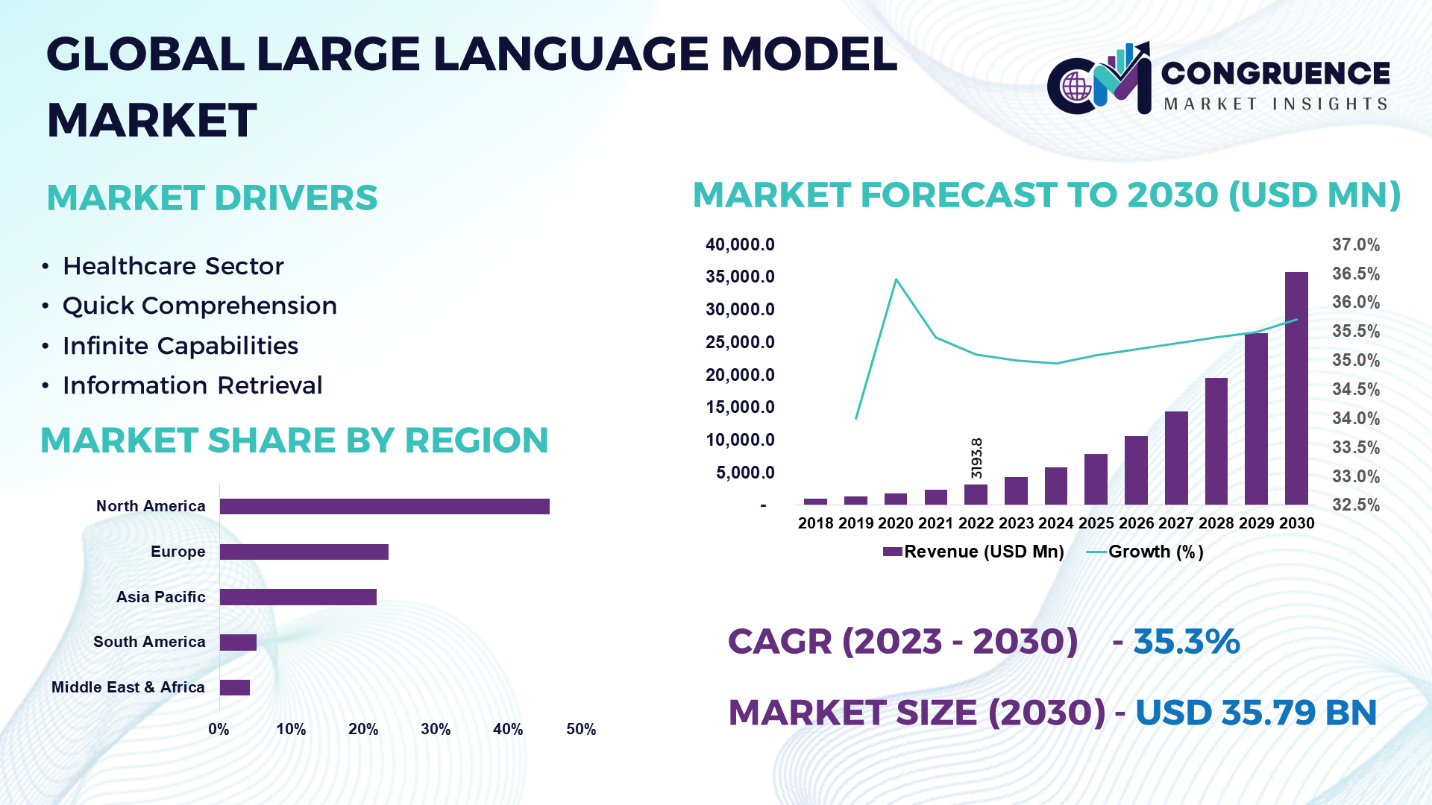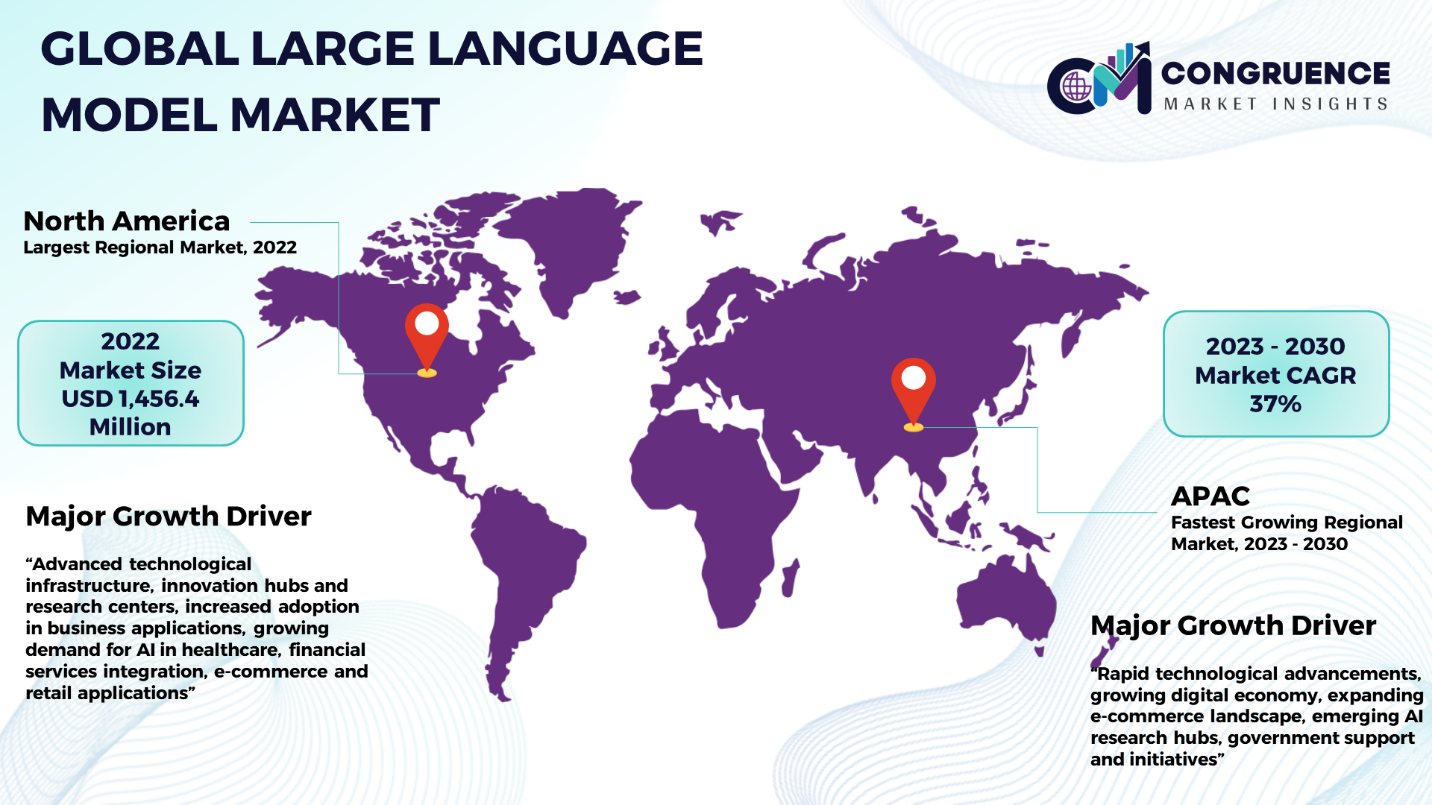Reports
The Global Large Language Model Market was valued at USD 3,193.8 Million in 2022 and is anticipated to reach a value of USD 35,786.8 Million by 2030 expanding at a CAGR of 35.3% between 2023 and 2030.
An artificial intelligence (AI) method known as a large language model (LLM) makes use of enormously big data sets and deep learning techniques to comprehend, synthesize, produce, and forecast new material. The phrase "generative AI" is also strongly associated with language learning modules (LLMs), which are a subset of generative AI designed exclusively to assist in producing textual material. Before generating new content based on the trained data, language models undergo training on a collection of data using several ways to infer associations. In natural language processing (NLP) applications, language models are frequently used to create results when a user types a query in natural language. The AI language model concept has evolved into an LLM, which significantly increases the amount of data available for inference and training. As a result, the AI model's capabilities are greatly increased. An LLM usually includes at least one billion or more parameters, while the exact size of the training data set isn't widely agreed upon. The variables in the model that were used to train it and allow for the inference of additional content are referred to as parameters in machine learning.

Large Language Model Market Major Driving Forces
Healthcare Sector: The use of these models has a significant impact on medical research and patient care. To guarantee patient satisfaction, an excellent connection between the patient and the caregiver is crucial. In order to enable caregivers to properly and thoroughly interact with patients, LLMs assist in providing accurate and comprehensible reports and diagnosis. These models also have an impact on medical practitioners' general decision-making process by offering the most recent medical.
Quick Comprehension: LLMs are excellent at condensing large amounts of text, identifying the important details, and producing succinct summaries. This is especially helpful for summarizing articles, research papers, and news stories fast. This might also be utilized to provide customer service representatives with instant ticket summaries, increasing their productivity and enhancing the clientele's experience.
Infinite Capabilities: The extent of AI's advancements and capabilities remains uncertain. AI's explosive rise in business and industry indicates that, despite the seemingly limitless potential for invention and progress, programmers have only just begun to scratch the surface. The service sectors will prosper and continue to provide consumers throughout the world with dependable, trustworthy care as AI functionalities become faster and more adept.
Information Retrieval: When it comes to information retrieval activities, LLMs are invaluable. They can efficiently filter through huge text databases to obtain pertinent information, making them vital for search engines and recommendation systems. To comprehend user queries and obtain the most pertinent web pages from its index, for example, a search engine uses LLMs.
Large Language Model Market Key Opportunities
Abundant Availability of Internet Data: The LLM market has advanced significantly due in large part to the widespread availability of internet data. This abundance of information provides LLMs with a solid foundation by allowing them to study from a variety of broad sources, which improves their performance and flexibility significantly. With access to so much data, learning may be more thorough and nuanced, helping LLMs get further opportunities in various fields.
Transfer Learning and Hardware Technology: LLMs have been improved by methods including transfer learning and self-supervised learning, which let them to apply previously learned information and adjust to new tasks more skillfully. Advances in hardware technology, particularly GPUs (Graphics Processing Units) and TPUs (Tensor Processing Units) have expedited training and inference procedures, enabling the handling of larger and more complicated models.
Application in Financial Sector: For financial service providers to safeguard the money and personal information of their clients, accurate data and dependable security are essential. LLMs are used in risk assessment, financial advice, and fraud detection. They assist professionals in avoiding any dangers associated with loans and investments by analyzing real-time financial data to spot fraudulent activity. Algorithms for machine learning enhance decision-making, enabling human advisers to offer tailored financial suggestions and assistance, owing to the sensitivity of the information in the sector.
Large Language Model Market Key Trends
· Ongoing research and development activities are focused on improving and enhancing big language model architectures.
· Large language models are becoming more and more specialized for use in legal services, banking, and healthcare, for example.
· Large-scale language models have raised concerns about biases. The sector witnessed an increase in the focus on moral AI procedures.
· To improve consumer interactions, large language models are being incorporated into different business applications.
· In order to promote cooperation between the research and development groups, many language model designs are created as open-source initiatives.
· Demand for multilingual language models that can comprehend and produce material in various languages has skyrocketed.
Region-wise Market Insights
North America accounted for the largest market share at 45.6% in 2022 whereas, Asia Pacific is expected to register the fastest growth, expanding at a CAGR of 37% between 2023 and 2030.

North America made up the largest part, with USD 1,456.4 million and a 45.6% revenue share. North America's strategic location as a hub for technological innovation, home to some of the world's best AI research institutes and tech firms, fosters the development and advancement of LLM technology and adds to its market domination. Early users of LLMs include a number of North American industries, including tech, finance, healthcare, and entertainment. The region's leadership in LLM development and consumption is cemented by its early adoption, which stimulates demand and future innovation. Furthermore, the area provides access to a wide range of resources, such as data, computing infrastructure, and opportunities for collaboration. Over the course of the projection period, Asia Pacific is expected to see an exceptionally massive CAGR of 37%. The Asia-Pacific area boasts an increasing number of digital residents along with a sizable and varied market. A wide range of sectors and consumer groups will have enough opportunity to embrace and utilize LLMs as a result of this market expansion. Innovative startups and digital enterprises with a focus on artificial intelligence and natural language processing are starting to appear in the region. By offering distinctive solutions to the market, these organizations are advancing the creation and uptake of LLMs.
Market Competition Landscape
The competitive landscape of the Global Large Language Model Market is characterized by intense innovation, strategic collaborations, and the presence of key players vying for dominance. Leading technology companies, including but not limited to OpenAI, Google, Microsoft, Facebook, and Baidu, have played pivotal roles in shaping the market dynamics. These companies have invested significantly in research and development to create state-of-the-art language models, pushing the boundaries of natural language understanding and generation. Moreover, the landscape includes emerging startups that focus on niche applications or specialize in industry-specific solutions, contributing to the market's diversity. Strategic partnerships between technology firms and industries such as healthcare, finance, and e-commerce have become commonplace, as organizations seek to leverage large language models to gain a competitive edge. Open-source initiatives also foster collaboration, enabling a broader community of developers and researchers to contribute to advancements in language model technology. As the market continues to evolve, competition is expected to intensify, with an increasing emphasis on ethical considerations, customization for specific industries, and the development of practical, real-world applications. Prominent players in the market include:
· OpenAI
· Microsoft
· Baidu
· IBM
· Salesforce
· Alibaba
· Amazon
· Tencent
· Intel
· NVIDIA
· Samsung Research
|
Report Attribute/Metric |
Details |
|
Market Revenue in 2022 |
USD 3,193.8 Million |
|
Market Revenue in 2030 |
USD 35,786.8 Million |
|
CAGR (2023 – 2030) |
35.3% |
|
Base Year |
2022 |
|
Forecast Period |
2023 – 2030 |
|
Historical Data |
2018 to 2022 |
|
Forecast Unit |
Value (US$ Mn) |
|
Key Report Deliverable |
Revenue Forecast, Growth Trends, Market Dynamics, Segmental Overview, Regional and Country-wise Analysis, Competition Landscape |
|
Segments Covered |
· By Deployment Model (Cloud-based, On-Premises, Hybrid) · By Application Domain (NLP Applications, Content Creation, Virtual Assistants, Sentiment Analysis, Language Translation, Speech Recognition) · By Industry (Healthcare, Finance, E-commerce, Legal, Education, Media, Customer Service) · By User Type (Enterprises, SMBs, Research Institutions, Individual Developers) |
|
Geographies Covered |
North America: U.S., Canada and Mexico Europe: Germany, France, U.K., Italy, Spain, and Rest of Europe Asia Pacific: China, India, Japan, South Korea, Southeast Asia, and Rest of Asia Pacific South America: Brazil, Argentina, and Rest of Latin America Middle East & Africa: GCC Countries, South Africa, and Rest of Middle East & Africa |
|
Key Players Analyzed |
OpenAI, Google, Microsoft, Facebook, Baidu, IBM, Salesforce, Alibaba, Amazon, Tencent, Intel, NVIDIA, Samsung Research |
|
Customization & Pricing |
Available on Request (10% Customization is Free) |
